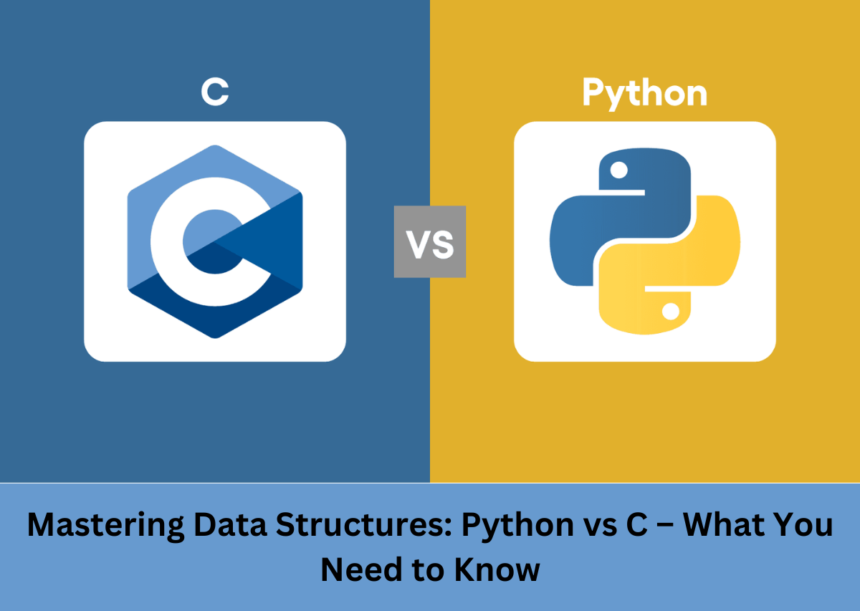Data structures are at the core of efficient programming. Whether you’re sorting through large datasets, optimizing search algorithms, or managing memory, understanding how to implement and utilize data structures is critical. But how does this differ between two of the most popular languages, Python and C? In this blog, we’ll explore the key differences in how Python and C handle data structures, memory, and performance. By the end, you’ll know when to choose one language over the other for your specific project needs.
Why Data Structures Matter in Programming
Before we dive into Python vs C, let’s first talk about why data structures are so essential in programming.
The Role of Data Structures
Data structures like arrays, linked lists, stacks, and queues allow programmers to efficiently store and manage data. They are crucial for improving the speed of algorithms, optimizing memory usage, and solving complex problems with minimal resources. Choosing the right data structure often means the difference between code that runs in seconds or hours.
Common Data Structures You Should Know
Some key data structures used in both Python and C include:
- Arrays: Fixed-size data collections.
- Lists: Dynamic collections in Python, or linked lists in C.
- Stacks and Queues: Linear data structures used for specific operations.
- Hash Maps: Used for fast lookups, known as dictionaries in Python or hash tables in C.
Both Python and C handle these data structures in very different ways, due to their language architectures and the way they manage memory.
Python vs C: Key Language Differences
Python: A High-Level, Dynamic Language
Python is known for its simplicity and readability. It’s a high-level language that abstracts much of the complexity involved in managing memory and implementing data structures. Built-in data types like lists and dictionaries make working with data easy and fast to implement.
However, with these advantages come trade-offs. Python’s abstraction layers can lead to slower performance because of its interpreted nature and dynamic typing system. For example, Python variables don’t require a type declaration—Python automatically figures out the type during runtime, making coding faster but less efficient in terms of performance.
C: A Low-Level, Performance-Oriented Language
In contrast, C is a low-level language, providing more control over memory and data structures. You don’t have built-in lists or dictionaries in C. Instead, you manually implement data structures like arrays and linked lists. This gives you complete control over how memory is allocated and managed, which can lead to significant performance boosts.
However, this control comes with added complexity. In C, you must declare the type for every C variable, and memory must be allocated and freed manually using functions like malloc and free. While C gives you power, it also places more responsibility on you as the programmer.
Memory Management: Python vs C
Python’s Automatic Memory Management
Python handles memory management through automatic garbage collection. This means that Python keeps track of all variables and data structures, cleaning up unused objects when they are no longer needed. For instance, when you declare a Python variable, you don’t need to worry about where or how the memory is being allocated. Python handles it behind the scenes.
However, this abstraction can lead to higher memory overhead. While it makes Python easy to work with, the garbage collector can introduce latency, especially in large-scale applications where memory needs to be handled more efficiently.
C’s Manual Memory Management
In C, memory management is entirely manual. When you declare a C variable, you must allocate memory explicitly, often using malloc, and free that memory when it’s no longer needed using free. This allows for precise memory control but also introduces the possibility of memory leaks if you forget to free allocated memory.
int *arr = (int*) malloc(5 * sizeof(int)); // Allocate memory for an array of 5 integers
free(arr); // Free the memory when you're done
This precision is great for performance but adds complexity, making C more difficult for beginners. It’s also why C is favored in performance-critical applications like game development or system programming.
Implementing Arrays in Python vs C
Arrays and Lists in Python
Python doesn’t have a built-in array type like C. Instead, Python uses lists, which are dynamic arrays. They automatically resize as you add or remove elements, making them easy to work with. For example:
my_list = [1, 2, 3, 4] # A Python list (dynamic array)
my_list.append(5) # Python handles resizing automatically
However, this convenience comes with a cost. Each time Python resizes a list, it creates overhead, which can slow down performance, especially for large datasets.
Arrays in C: Control and Performance
In C, arrays are fixed in size, meaning you must declare their size upfront. This gives you more control over memory usage and performance, as no dynamic resizing is required. For example:
int arr[5] = {1, 2, 3, 4, 5}; // A static array in C
If you need to resize an array in C, you’ll need to manually allocate new memory and copy the elements. While this gives you more control and efficiency, it also adds complexity to the code.
Linked Lists: Python vs C
Linked Lists in Python
Python does not have a native linked list data structure, but you can implement a linked list using classes and objects. However, Python lists (dynamic arrays) can often substitute for linked lists in simple use cases, although they lack the true benefits of linked lists in terms of efficient insertion and deletion.
Linked Lists in C
In C, linked lists are often implemented using pointers. Each node in the list contains a pointer to the next node, allowing for efficient insertions and deletions. This gives you full control over how the memory is managed, but it also requires a good understanding of pointers and memory management.
struct Node {
int data;
struct Node* next;
};
With manual memory management, C allows for more efficient data manipulation when working with large datasets compared to Python.
Stacks and Queues in Python vs C
Python’s Built-in Stack and Queue Support
Python’s deque from the collections module provides built-in support for stack and queue operations. This makes implementing these data structures simple and quick.
from collections import deque
stack = deque()
stack.append(1)
stack.pop()
While convenient, these built-in structures come with performance overhead due to Python’s interpreted nature.
Implementing Stacks and Queues in C
In C, you must manually implement stacks and queues, either using arrays or linked lists. This adds complexity but offers better performance, as you can manage memory and operations more precisely.
struct Stack {
int top;
unsigned capacity;
int* array;
};
The trade-off between Python’s ease of use and C’s manual control is clear when handling these structures at scale.
Hashing: Python’s Dictionaries vs C’s Hash Tables
Dictionaries in Python
Python’s dictionaries are built-in and highly optimized for fast key-value lookups. Behind the scenes, Python uses a hash table to implement dictionaries, and all memory management is handled for you.
my_dict = {'key1': 'value1', 'key2': 'value2'}
This makes Python dictionaries incredibly easy to use, but again, at the cost of performance when compared to C’s manual implementations.
Hash Tables in C
In C, you must manually implement hash tables, managing memory, hash functions, and collision handling. While this requires more work upfront, it allows for significant optimizations based on your specific use case, leading to faster lookup times.
struct HashTable {
int size;
struct Node** table;
};
Performance Comparison: Python vs C
Execution Speed: Python’s Flexibility vs C’s Efficiency
Python’s flexibility and high-level abstractions make it slower compared to C, especially for performance-critical applications. In contrast, C is a compiled language that runs directly on the hardware, making it much faster.
For instance, a simple loop in Python will run slower than in C, as Python interprets the code at runtime, while C compiles directly to machine code.
Memory Usage: Python’s Abstraction vs C’s Precision
Python’s automatic memory management is convenient but leads to higher memory overhead, especially with large data structures. In C, you have precise control over memory allocation, allowing for more efficient memory usage, but with the added responsibility of manually managing that memory.
Ease of Use and Learning Curve
Python’s Simplicity and Faster Development
For beginners, Python is easier to learn due to its straightforward syntax and automatic memory management. This makes it ideal for rapid prototyping, small projects, and applications where development speed is more important than raw performance.
C’s Complexity and Power
C, on the other hand, has a steeper learning curve due to its manual memory management and low-level operations. However, once mastered, C offers unparalleled control and performance, making it the language of choice for system-level programming, embedded systems, and performance-critical applications.
Conclusion
Both Python and C are powerful languages for implementing data structures, but they cater to different needs. Python excels in ease of use, with high-level abstractions and built-in support for common data structures, making it great for rapid development. C, on the other hand, offers superior performance and memory control, ideal for system-level programming and performance-critical applications.







